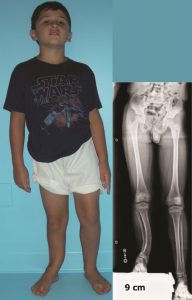
Posteromedial bowing of the tibia presents at birth as a severe-appearing deformity. The child is born with the top of the foot nearly touching the front of the tibia. Parents are usually appalled at the appearance of the deformity. While appearing severe, the deformity is actually relatively benign and is characterized by a bowing of the tibia and a calcaneovalgus (heel bone) foot deformity.
With time, the severe calcaneovalgus foot will straighten out almost completely. Over time, the deformity of the tibia will also remodel. The tibial deformity has its most prominent angulation in the diaphysis (midsection) of the tibia while the bowing occurs at its apex posteromedially (behind and to the inner side). What is often unappreciated is that there is an associate angulation in the upper tibia into varus (inward) compensating for deformity in the midsection of the bone, which is in valgus (outward). Similarly, in the upper tibia, there is flexion or procurvatum (bending forwards) compensating for the significant recurvatum (bending backwards) deformity in the midsection.
The other deformity that often goes unrecognized is that the ankle is attempting to compensate for the severe valgus and recurvatum via inversion and plantar flexion (extension of the ankle down) respectively. Since the ankle has its greatest range of motion in plantar flexion, this deformity goes unnoticed when the foot goes into a plantigrade position (foot flat on the ground) despite significant recurvatum at the ankle joint or above. Similarly, since the ankle has its greatest motion in the frontal plant at the subtalar joint into inversion, it goes relatively unnoticed that the valgus bony deformities are being compensated for by subtalar inversion or varus (inward rotation). Over time, these compensatory deformities (plantar flexion and inversion) become fixed; therefore, there is often an associated soft tissue contracture of plantar flexion at the ankle joint and inversion at the subtalar joints that is unrecognized. In order to identify it, one needs to dorsiflex the foot (pull the foot upward) to see if the foot goes into the same amount of deformity as the recurvatum of the bone or if the foot is more restricted than the amount of angulation in the bone. Similarly, in the frontal plane, one needs to evert the foot (turn outward) into the deformed valgus position to see if there is any compensatory fixed inversion varus present. These associated contractures lead to potential long-term problems if left unrecognized.
If left untreated, the majority of the midsection deformity of the tibia will completely remodel, leaving a very mild scoliosis of the bone. The scoliosis comes from the upper tibial varus combined with the midsection tibial valgus. This bi-apical angulation effectively translates into a single angular deformity in the supramelleolar region: a valgus ankle. Similarly, the upper tibial procurvatum combined with midsection tibial recurvatum may present only as a recurvatum deformity at the ankle. The persistent inversion and equinus contractures compensate for these deformities and often go unrecognized. With time, the uncovering of the ankle from the recurvatum and valgus can lead to degeneration of the ankle joint and subsequent arthritis.
In summary, posteromedial bowing of the tibia is characterized by two deformities in the tibia, in two locations and in opposite directions. Over time, these deformities will correct themselves; however, in doing so, a resultant deformity of the ankle arises that is subtle and difficult to recognize. Without sufficiently addressing the ankle deformity, patient is at risk for ankle degeneration and arthritis.
The other major difficulty arising from posteromedial bowing of the tibia is a limb length discrepancy. the leg length discrepancy varies from 3 to 11 cm depending on the severity of the case. This limb length discrepancy follows a congenital pattern and is therefore predictable using the multiplier method.